Midnight madness on murder mile
The North Bank of the Nene is the roadside stretch of an artificial channel that was dug out in the Fifteenth Century. Stretching eastwards for twelve miles from the outskirts of Peterborough, it originally collected the waters of several Nene tributaries, diverting the main watercourse from its old northerly route, eastwards towards Wisbech and The Wash. The non-tidal water now ends four miles downstream from the Peterborough embankment, at the head sluice adjacent to the Dog-in-a-Doublet pub. On this length, fishing is only permitted on the north bank, hence the name. If you are a cow or a horse you will probably know it as the South Bank.
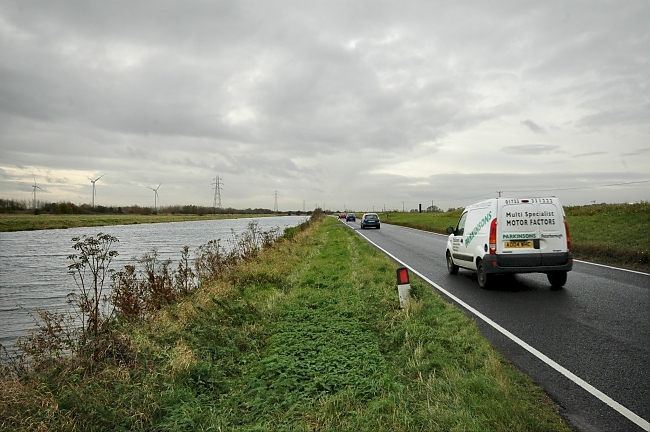
The North Bank looking towards Peterborough, home to large carp, lunatic
drivers and the occasional murderer
Forget the majesty of the Thames, the grandeur of the Severn or even the romance of the Avon; the River Nene, or Nen as it is referred to by idiots, is merely a sluggish fenland drain, transporting the filth and detritus of the denizens of Peterborough to eventual burial in the silt of The Wash. If your first visit is in cold and wind-swept conditions, it is all to easy to succumb to negative thoughts and you may find yourself having to fight the nagging thoughts in your mind that there may not be a carp within a mile in either direction. By way of compensation, the carp grow big, definitely into mid-thirties, with the upper limit open to speculation. In an era of lost innocence where named carp are caught almost weekly, the rivers provide the last refuge for those who wish to venture into the unknown.
Along the bottom half of this length runs the extremely busy and bumpy B666, on which the local psychopaths hold speed trials. Back at the top end, where the fen road first meets the river, there is a slope down to the grass verge that looks ideal for fishing, but in fact, it was thoughtfully provided by the local authorities to facilitate the torching or submersion of stolen cars by under-privileged youngsters.
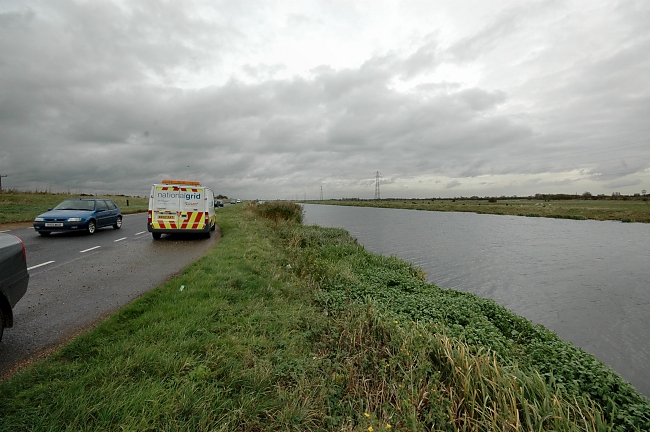
And it's just as pretty looking towards the head sluice. Be careful not
to hook a car while you're casting
When the wind is in the west, you may be fortunate enough to savour the caustic aroma of the brickyard chimneys, mixed into a heady concoction when combined with the heavenly fragrance of the Eastgate sewage works. So you sit there, gradually hypnotised by the Doppler effect on the engines of the passing cars, uplifted (almost literally) by their wake, then dusting the lead deposits that garnish your sarnies. Passing motorists lean out of their windows as they drive along, and call out for their lost dogs, which strangely, all seem to be named Wanker. You enjoy the gentle lapping of the water as cruisers hurtle past on this de-restricted mile, and the merry tinkling of the cans and bottles as they bob around in the margins. What sad empty fools, you think to yourself, as the disco booze cruise surges past to deposit its cargo of revellers at the downstream pub.
The chosen area for the North Bank campaign was a stretch of the river close to a small hand sluice on the far bank; a known bream holding area, where I had seen a few carp on my earlier visits and where I had seen carp anglers in seasons past. For an area of about one hundred yards, centred on the sluice, there is a depression on the river bed, where the depth increases to approximately fifteen feet at normal levels, compared to a steady rise to around nine or ten feet, three pegs upstream. This counts as a major feature on the North Bank. If you threw a brick into your swim it would count as a major feature on the North Bank.
Rob was the first to fish, as his shift work enabled him to grab some weekday sessions. I was in Sheltons tackle shop on the Saturday morning, handing over the compulsory percentage of my earnings, when Rob came in with a big grin on his face. "Three carp, two commons and a mirror." I didn't take too much notice of this, as Rob lost contact with reality a great many moons ago and North Bank carp don't exist in threes. "Seven and a half, eight and a half, and a little mirror of about three." This was obviously a disarming tactic, as Nene carp also don't exist until they are at least ten pounds. After he repeated his mantra several times without making a mistake, I thought he just might be telling the truth. The size of the fish didn't matter to me at this stage, all that mattered was that it was possible to fish for these carp and catch them.
A few hours later I was down there. On a very wet summer afternoon, a nine pound mirror intercepted a bait placed tight against the far shelf. It may have been a small fish, but I felt quite ecstatic at breaking my duck on this desolate water. It put things into perspective when a pleasure angler who photographed it for me exclaimed that he didn't know there were fish of that size in there.
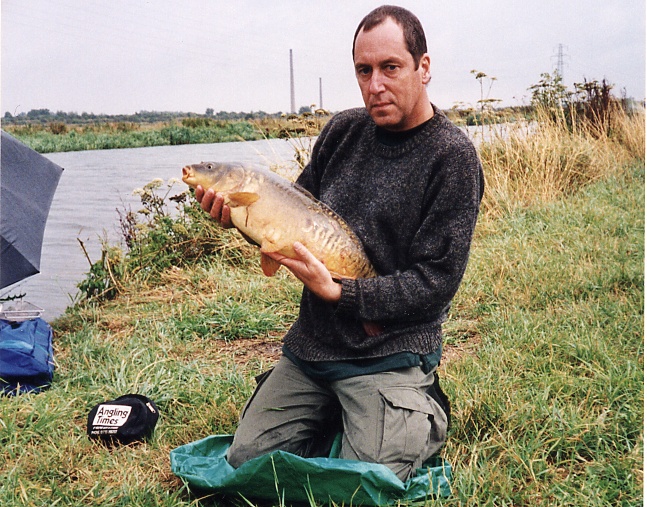
Only a small carp on a wet afternoon, but it proved they really were there and that they could be caught
Although pleased at this early success, we decided to move after a tip-off from the bailiff assured us that huge numbers of thirties had been seen in a post-spawning feeding frenzy in a certain heavily weeded area. How could we fail? Rob had recently started to use Rod Hutchinson's Secret Agent in his baits, which ensured that his car, clothes, pores and nearby Whittlesey, all stank of the stuff: the blameless Indian take-away was subsequently closed down by Environmental Health officials for releasing excessive fumes into the atmosphere. Rob's central nervous system had been completely stunned into submission by the stuff, and he couldn't understand what I was complaining about. He would point out the clouds of bubbles rising from his baited area as evidence of feeding carp, totally oblivious to the yellow, sulphurous fog that clung to the surface and the smouldering, drifting carcasses of the recently deceased coot family. Although a combined baiting effort was obviously an applaudable idea, I was damned if I was going to handle that stuff without at least donning a wetsuit and rubber gloves.
So I joined in, lobbing out a hemp, maize meal and chickpea bombardment, but stuck to my own wonderfully fragrant and desirable cream and vanilla concoctions as hook bait. I don't mind exuding the aroma of a cake shop, but I draw the line at sitting in the confined space of a bivvy, smelling as if I've just spent the past week delivering calves.
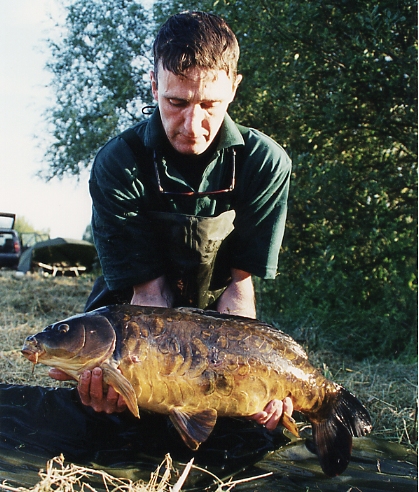
Rob Curtis, purveyor of exotic chemicals, displays a prehistoric carp
Retreating to my swim, I sat back in my chair to watch the fenland sun sink behind the brick works chimneys, watching a barn owl quartering the water meadows beyond the far bank. When directly opposite, it hovered for a brief moment before plunging down into the grass, emerging with a limp, furry body in its talons. Mission accomplished, it crossed the river and flew off over the fields with its warm vole take-away.
On warm, summer evenings, the sunset painted water shatters into dazzling fragments of gold and orange, as bronze backs break the surface tension. As the light begins to fade, zander start their dusk patrol, striking noisily at the small fry swarming in the margins. Before long a near silence descends, the only sounds coming from the spiralling clouds of midges and the foraging of voles in the bankside reeds. A short period of calm and tranquillity is replaced by mounting tension, as the hunting instinct takes over and adrenalin is drip fed into the veins. You relax back into your bedchair, drinking in the atmosphere as the night watch begins.

I only caught two in broad daylight. Between 11pm and 12 pm were the best times, with another spell at 3am
I settled down for the night, listening to a surreal radio phone-in, where the main topic for the night was an invitation to enlighten fellow listeners by revealing the most unusual product that they had purchased in a tin. The massed ranks of the barking mad, ranging from the quaintly senile to the mildly psychotic, were queuing up to reveal the contents of their bubonic larder pits. One caller even phoned in to reveal that he had some artichokes, but then thought that they might just be runner beans, then put the phone down while he went to have a look.
I dozed off to the distant, muffled sounds of doors banging, of tins rattling, followed by an argumentative discourse, that may, or may not, have involved more than one person. Some time later, I was shocked back into reality by the nostril hair searing presence of Rob, who came to tell me that Fisherman's Blues was on the radio. Now this is a weird programme, mainly about match angling, but broadcast at times that must ensure that it is only ever heard by carp anglers and insomniacs. The whole hour was dedicated to the world championships and featured an interview with someone with the unlikely name of Bob Nudd. Bob seemed to be an expert on bolognese, and has balls the size of oranges. At least it passed the time until the last of the drunken motorists weaved their way home, allowing a mad kamikaze cyclist with no lights to stand an even chance of reaching the end of this dark, unlit road, thus depriving the magpies of their breakfast.
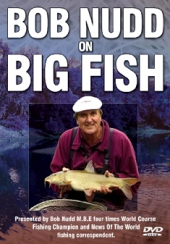
Bob Nudd - balls the size of oranges
An instantaneous take can distort reality and numb the senses, as the spinning baitrunner screams to be heard above the banshee howling of the alarm. The whole setup rocks, a rod arcs round in the rests and an unseen adversary tears line from the spool at a frightening rate. A half turn of the reel handle engages the clutch, the rod tip slams down, and something out there in the darkness is very angry indeed.
Carp hooked in rivers have the nasty habit of bolting off parallel to the nearside bank, putting as much distance between them and their tormentor in as short a time as possible. Once this has been achieved to their satisfaction, they are free to bury themselves in whatever cover is available, as the angle created makes it almost impossible to stop them. There is only one tactic the angler can adopt in this kind of situation: run after them like a thing possessed, while winding like fury to keep the line as tight as possible. If you have failed to reconnoitre your territory in daylight, this is when you find all those holes in the ground and the unfeasibly large and smelly deposits left by unidentified bank side creatures.
As the carp is drawn to the net, your eyes zoom in on the hook-hold in the gaping mouth, an image seemingly magnified and retained by persistence of vision as it bores away in a flurry of spray. Finally, the beaten fish is drawn over the net and the hook releases its fragile hold as the mesh envelopes its prey. From this moment on I suffer anxiety and pangs of guilt, as I am torn between the urge to weigh and photograph this beautiful fish and to return it to the water as soon as possible. An early morning carp from the North Bank is likely to be seen by the first commuters as they speed by on the way to work. Yes, I admit it; as the photograph is taken, I hold it to the morning sun to display it, resplendent in its brassy glory, merely to let them glimpse a snapshot of a world beyond their comprehension.
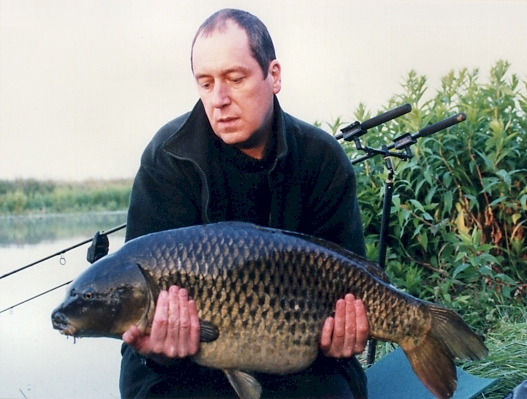
The culmination of a prolonged campaign - a pristine Nene common of 25lbs 10ozs